- AC NM AE T1 mine
The AC NM AE T1 is a Brazilian minimum metal anti-tank blast mine. The mine is believed to be in service with the Brazilian army, although production of the mine ceased in 1989. The mine has a square plastic main body, with a raised circular pressure plate and fuze. A carry handle is built into...
- ADWAT mine
ADWAT is a French anti-tank blast mine used with the Matenin mine laying system. The mine has the same casing as the MI AC PR series of mines. The mines has a mechanical and electronic fuze. The mine incorporates a 30-minute arming delay, after which either the electronic or mechanical fuze can...
- AT-8 (Cuban mine)
The AT-8 or Cuban anti-tank mine is a square green plastic cased anti-tank mine. It is a scaled up version of the Cuban anti-personnel mine. The mine consists of a plastic ribbed hinged upper case which rests on the fuzes placed into the lower platic case. When enough pressure is placed on the...
- ATM-72 mine
The ATM-72 is a steel cased circular North Korean anti-tank mine. It is similar to the Russian TM-46, with a thick wire carrying handle and a filling plug. The mine uses a four pronged fuze, downward pressure on any of the levers will trigger the mine...
- ATM-74 mine
The ATM-74 is a North Korean wooden box mine, it is a copy of the Russian TMD-B. It is a wooden box packed with blocks of TNT, the top of the mine has three planks of wood underneath the central plank is a pressure fuze similar to Russian MV-5 pressure fuze....
- ATM 75 mine
- ATM 96 mine
The ATM 96 is a plastic cased Austrian anti-tank mine produced by Dynamit Nobel Wien. The mine had a dome shaped pressure plate, and an optional tilt rod fuze....
- BLU-91
The GATOR mine system is a US system of air-dropped anti-tank and anti-personnel mines, that was developed in the 1980s to be compatible with existing cluster dispensers. It is used with two dispenser systems — the Navy 500 lb CBU-78/B and the Air Force 1,000 lb CBU-89/B...
- C-3-A/B mine
The Expal C-3-A and C-3-B are round Spanish rubber modified polystyrene cased anti-tank blast mines. The mines differ only in minor detail. The mine is classified as a minimum metal mine, the only metal it contains being a 4.5 millimetre diameter zinc-plated steel spring. The mine is found in...
- Cardoen AT mine
The Cardoen AT mine is a circular steel cased Chilean anti-tank blast mine that was produced by Industrias Cardoen SA. The mine is conventional in design with a central pressure plate held between three flexible tabs, underneath the pressure plate is a simple mechanical detonator. The mine has a...
- CC 48 mine
The CC 48 is an Italian wooden cased minimum metal anti-tank mine that was used during the Second World War. The mine uses a shaped TNT explosive charge to produce a directional cutting effect...
- CS 42/2 mine
The CS 42/2 is an Italian wooden cased anti-tank mine used during the Second World War. The mine uses four PMC 43 buttons, which can be substituted for Model 42/2 fuzes to make it function as an Anti-personnel mine.-Specifications:...
- CS 42/3 mine
The CS 42/3 is an Italian wooden cased anti-tank mine used during the Second World War. Like the earlier CS 42/2 mine it uses four PMC 43 fuzes. It is a minimum metal mine, containing no metal.-Specifications:* Dimensions: 284 x 236 x 144 millimeters...
- DM-11 mine
The DM-11 is a german anti-tank mine popular in countries of Africa, not suited to be disarmed or neutralized...
- Flachmine 17
The Flachmine 17 was a German landmine mass produced during the First World War. Production of the mine began in 1916 after the appearance of British and French tanks, and by the end of the war over three million had been produced...
- FMK-3 mine
The FMK-3 is a fibreglass cased Argentine anti-tank blast mine. It is produced by Direccion General de Fabricaciones Militares. The mine actually uses a FMK-1 anti-personnel mine as a fuze, the FMK-1 is modified with a pressure cap to increase the activation pressure...
- FMK-5 mine
The FMK-5 is a circular Argentinian minimum metal anti-tank blast mine. Like the FMK-3 mine it uses a FMK-1 anti-personnel mine as a trigger. The FMK-1 is fitted with a stiff cap to increase its activation pressure to 300 kg...
- Hawkins grenade
The Grenade, Hand, Anti-tank, No. 75, also known as the Hawkins grenade was a British anti-tank hand grenade used during World War II. It was one of a number of grenades developed for use by the British Army and Home Guard in the aftermath of the Dunkirk evacuation...
- LPZ mine
The L.P.Z. mine or Leichte Panzermine was a circular metal cased German anti-tank mine produced during the Second World War. The mine was accepted into service in 1941,and were intended for use by Paratroops. Production of the mine ended in 1942 with only 31,700 mines produced...
- M1 mine
The M1,M1A1 and M4 are circular steel cased U.S. anti-tank blast mines with a distinctive cross shaped pressure spider. The mine was used during the Second World War and a copy produced in Argentina was used during the Falklands War. Another copy is produced in China. designated the No.4 mine...
- M1A1
The M1,M1A1 and M4 are circular steel cased U.S. anti-tank blast mines with a distinctive cross shaped pressure spider. The mine was used during the Second World War and a copy produced in Argentina was used during the Falklands War. Another copy is produced in China. designated the No.4 mine...
- M4 mine
The M1,M1A1 and M4 are circular steel cased U.S. anti-tank blast mines with a distinctive cross shaped pressure spider. The mine was used during the Second World War and a copy produced in Argentina was used during the Falklands War. Another copy is produced in China. designated the No.4 mine...
- M5 mine
The M5 is a U.S. minimum metal plastic cased anti-tank blast mine. The mine uses either a glass or porcelain internal case with a protective outer case. The mine uses a chemical fuse rather than a mechanical one. It contains either 5.4 lb of TNT or 5.7 lb of tetrytol...
- M6 mine
The M6, M6A1 and M6A2 are a series of metal cased circular anti-tank landmines produced by the United States, they were superseded in service by the larger M15 mine. The mine is normally painted olive green and has a large central pressure plate. In the centre of the pressure plate is an arming...
- M7 mine
The M7 is a small metal cased U.S. anti-tank blast mine that was used during the Second World War. It was based on the British Hawkins grenade. Approximately 2.5 million were produced before production ceased, and although it has long since been withdrawn from U.S...
- M15 mine
The M15 mine is a large circular U.S. anti-tank blast mine, first deployed during the Korean War. Essentially, it is a larger version of the M6A2 anti-tank mine, which it superseded.-Description:...
- M19 mine
The M19 is a large square plastic cased U.S. anti-tank blast mine. The design dates from the mid-1960s and has only two metal components: the copper detonator capsule and stainless steel firing pin which weighs 2.86 grams. It is a minimum metal mine, which makes it very difficult to detect after it...
- M51 MACI mine
- M52 MACI mine
- M/71 mine
The M/71 is a large Egyptian metal cased anti-tank blast mine based on the Russian TM-46 landmine. It is found in Egypt and Somalia. The mine is normally painted sand colored...
- M75 mine
The GEMSS mine system was a US mine system, replaced in US service by the Volcano mine system. The mines are deployed from either the towed M128 "Frisbee Flinger" and the M138 "Flipper" portable mine layer.-Mines:...
- M/80 mine
- M453 mine
- M1935 mine
The M1935 is a French heavy anti-tank mine. It consists of a large heavy steel base plate with a hinged thin steel lid. Inside the lid it has a rectangular steel container, which holds the explosive charge. The mines are laid at a minimum interval of six feet.A pressure of eight hundred pounds...
- M1936 mine
The M1936 is a French light anti-tank mine used during the Second World War. The mine was captured in large numbers by the German army after the Fall of France, and was later used in North Africa and Italy. The mine consists of a base plate on top of which is a rectangular steel box containing an...
- MAT/5 mine
The MAT/5 is an Italian circular plastic cased minimum metal blast resistant anti-tank blast mine. It uses a pneumatic fuze which is resistant to shock and blast, and is also claimed to be resistant to mine flails and mine rollers. The mines plastic case is water proof, and it can be laid in...
- MAT/6 mine
The MAT/6 is an Italian circular synthetic resin-cased minimum metal blast resistant anti-tank blast mine. It uses a pneumatic fuze which is resistant to shock and blast, and is also claimed to be resistant to mine flails and mine rollers. The mine's plastic case is waterproof, and it can be laid...
- MAT-62B mine
The MAT-62B is a Romanian plastic cased circular anti-tank blast mine. It is very similar to the Russian TM-62P2. The mine has a central fuze well which accepts the bakelite P-62 pressure fuze, which contains a CD-11R detonator. The mine can accept fuzes from the Russian TM-62 and TM-72 series of...
- MAT-76 mine
The MAT-76 is a large circular Romanian minimum metal anti-tank blast mine. It is similar to the MAT-62B mine, sharing a fuze. The mine is actually a cast block of TNT with a thin coating of fibreglass. The mine has a central fuze well that normally uses a P-62 pressure fuze, although it can be...
- MAT.84-F5 mine
The MAT.84-F5 is a Chilean, plastic cased, minimum metal anti-tank blast mine. The mine has a small central pressure plate on the top of the case which is made from 3 mm thick, olive green, high-impact plastic. The mine is armed before it is laid by unscrewing a safety plug from the side of the mine...
- MATS/1.4 mine
The MATS/1.4 is a scatterable Italian circular plastic cased minimum metal blast resistant anti-tank blast mine. It uses a pneumatic fuze which is resistant to shock and blast. The mines plastic case is water proof, and the mine can be scattered from a helicopter travelling at up to 200 km/h. The...
- MATS/2 mine
The MATS/2 is a scatterable Italian circular plastic cased minimum metal blast resistant anti-tank blast mine. It uses a pneumatic fuse which is resistant to shock and blast similar to the fuse fitted to the TS-50. The mines plastic case is water proof, and the mine can be scattered from a...
- MATS/2.6 mine
The MATS/2.6 is a scatterable Italian circular plastic cased minimum metal blast resistant anti-tank blast mine. It is very similar to the MATS/2, except that it uses a smooth pressure plate rather than a griddle pressure plate. It uses a pneumatic fuse which is resistant to shock and blast similar...
- MGP-31 mine
The MGP-31 is a scatterable Peruvian circular, plastic cased minimum metal blast resistant anti-tank blast mine. The mine has a central domed pressure plate, and a ribbed edge. It will function upside down. Little is known about the mine, and it is believed to be in service with the Peruvian armed...
- MI AC PR mine
The MI AC PR are a series of French minimum metal blast resistant mine anti-tank blast mines. The mines can be laid by hand or automatically from the Matenin mine laying system at a rate of 500 per hour. The mines use a clockwork arming delay, which can also self neutralize the mine after a set...
- Mk 2 mine
The Mark II mine or A./T. Mine G.S. Mk II was a small British anti-tank blast mine used during the Second World War. The consisted of a body about seven inches in diameter and two inches high . The mine has a central fuze well accessed from the bottom, with a main charge in a cavity around the...
- Mk 3 mine
The Mk 3 mine or Mine G.S. Mk III was a British anti-tank mine used during World War II. The mine had a cylindrical tin lower body with a steel pressure plate which sits on top of a shear-wire restrained spring-loaded striker. Sufficient pressure on the cover shears the restraining wire, allowing...
- Mk 4 mine
The Mk 4 mine or Mine G.S. Mk IV was a British anti-tank mine used during World War II. Externally the mine has a cylindrical main body filled with explosive either TNT or Baratol. The mine is covered by a pressure plate, which is attached to the mine body by four pins which sit in vertical slots...
- Mk 5 mine
The Mk 5 or Mine G.S. Mk V was a cylindrical metal cased U.K. anti-tank blast mine that entered service in 1943, during the Second World War. It was replaced in British service with the Mk 7 mine....
- Mk 7 mine
The Mk 7 mine is a circular U.K. anti-tank blast mine. It can be laid either by hand or from a mechanical mine layer. The mine is conventional in design, with a central fuze well, below which is a booster charge, both surrounded by the main charge. The mine can be fitted with a variety of fuzes,...
- MKT Mod 72 mine
The MKT Mod 72 is an Albanian circular metal cased anti-tank blast mine, a copy of the Russian TM-46. Two versions of the mine are produced, the PX designated version of the mine is fitted with a secondary fuze well in the base of the mine that accepts an MUV type anti-lifting device...
- MKTBT mine
The MKTBT is a large circular bakelite cased Albanian anti-tank blast mine. The mine uses a mechanical pressure fuze, copied from the Russian MV-5. The mine has relatively low metal content, including a metal carrying handle and fixing brackets, as well as six screws in the top of the mine...
- Model 41-47 mine
- Model 47 mine
- Model 47-52 mine
- Model 52 mine
The Model 52 mine is a Swedish circular plywood cased anti-tank blast mine. It is currently in service with the Swedish army. The mine can be fitted with a number of different fuzes and pressure plates including a three pronged plate and a pentagonal pressure spider and a tilt-rod...
- Model 67 mine
The Model 67 is a square plastic cased Austrian minimum metal anti-tank blast mine. The mines pressure fuze sits on the top of the mine, with a provision for an anti-handling device. A second version of the mine the ATM-75 is similar to the Model 67 mine....
|
- MP-APVL 83-F4 mine
The MP-APVL 83-F4 is a Chilean anti-tank blast mine based on the U.S. M1A1 mine. The mine has a plastic body with distinctive pressed steel pressure spider on the top. The main charge of the mine has 3.5 kg of steel balls embedded into the charge...
- MPP-B Wierzba mine
The MPP-B "Wierzba" is a fibreglass Polish minimum metal anti-tank blast mine. The mine is similar to the Russian TM-62 series and is compatible with the same fuses. It is normally used with a MWCz-62 fuse with a clockwork arming delay, which is a copy of the Russian MVCh-62...
- Na-Mi-Ba mine
The Na-Mi-Ba is a Czechoslovakian minimum metal bakelite cased anti-tank blast mine. The mine uses a horizontal lever fuze, with a very low operating pressure that breaks open a glass capsule containing acid, which initiates a flash composition. The mine has a small main charge, and is normally...
- No 6 mine
The No 6 mine is an Israeli metal cased anti-tank blast mine. It is a direct copy of the Russian TM-46 mine, the only notable difference being the filling cap, which is domed on the TM-46 and flat on the No 6. It can be fitted with the No 61 pressure fuze or a No 62A tilt rod fuze...
- No 8 mine
The No 8 mine is a South African circular plastic cased minimum metal anti-tank blast mine. The mine has a large pressure plate on top of which is an oversize arming lever whose position at either of two sets of lugs either indicates "ARMED" or "SAFE". The mine can be fitted with a number of...
- NR 25 mine
The NR 25 is a circular Dutch steel cased anti-tank blast mine. It is broadly similar in appearance to the German Tellermine 43, although it is larger. The mine has a central domed pressure plate, underneath which is an NR-29 mechanical pressure fuze, which is inserted into a fuze well. A doughnut...
- NR 26 mine
The NR 26 is a Dutch circular minimum metal anti-tank blast mine similar to the French M51 MACI. The mine uses an NR 26 friction pressure fuze with a sheer collar designed to give way at a load of 350 kg...
- NV-41 mine
The NV-41 was a wooden-cased Soviet anti-tank blast mine used during the Second World War. The mine consists of a square wooden box with a filling plug on the bottom. The top of the box is covered by a thin pressure lid, which covers a pressure plate held up by a spring. Sufficient pressure on the...
- P2 Mk2 mine
- P3 Mk2 mine
The P2 Mk2 and P3 Mk2 are Pakistani plastic cased minimum metal anti-tank blast mines. The P2 Mk2 has a square case with a central circular ribbed pressure plate, the P3 is circular with a central circular pressure plate. Both mines use anti-personnel mines as the fuse, typically the either the P4...
- Panssarimiina m/36
The Panssarimiina m/36 is a Finnish anti-tank blast mine used during the Winter War, Second World War and Continuation War. The mine was the first purpose built anti-tank mine to enter service with the Finnish Army, and was designed by Lieutenant Colonel T. Raatikainen and Lieutenant Colonel...
- Panssarimiina m/39
The Panssarimiina m/39 is a Finnish anti-tank blast mine used during the Winter War, Second World War and Continuation War. The mine superseded the Panssarimiina m/36 in service with the Finnish Army. It was first delivered in December 1939 while the Winter War was taking place...
- Panssarimiina m/S-39
- Panssarimiina m/S-40
- Panssarimiina m/44
The Panssarimiina m/44 is a Finnish anti-tank blast mine. It entered service in 1944 and was used during the Second World War and Continuation War. The mine used a wooden case, consisting of an upper box containing the main charge and a downward facing fuze, this was placed into a sturdy wooden...
- Pappmine
- PDM-1 mine
- PDM-1M mine
- PDM-2 mine
- PDM-2M mine
- PDM-6 mine
- Pignone mine P-1
- Pignone mine P-2
- PM-60 mine
The PM-60 or K-1 is a German round plastic cased minimum metal anti-tank blast mine. The case of the mine consists of two halves joined together by sixteen plastic nuts, giving the mine a distinctive appearance. The top of the mine has a large pressure plate which rests on top of the fuze assembly...
(K-1 mine)
- PMZ-40 mine
The PMZ-40 was a circular metal-cased Soviet multi-purpose landmine used during the Second World War. It was similar in design to the earlier Finnish Panssarimiina m/36 which was used during the Winter War. The mine had a serrated lower edge that allowed it to be deployed on sheet ice...
- PRB M3 mine
The PRB M3 and PRB M3A1 are plastic cased minimum metal anti-tank blast mine produced by the Belgian company Poudreries Réunies de Belgique in the 1970s and 1980s. The mine is square with a olive drab...
- PRB-111 mine
The PRB-111 is a square Belgian minimum metal anti-tank blast mine that consists of a block of explosive which may or may not be coated in asphalt. A central cavity on the top surface is covered by a plastic pressure plate, underneath which is a small well for a pressure fuze. The fuze used with...
- PT-56 mine
The PT-56 is a rectangular plastic cased Yugoslavian minimum metal anti-tank blast mine. It is very similar in appearance and size to the TMA-2, which has superseded it.-Specifications:* Length: 260 mm* Width: 330 mm* Weight: 7 kg...
- PT Mi-Ba mine
The PT Mi-Ba The PT Mi-Ba The PT Mi-Ba (also known as the PT Mi-Ba-53 is a circular Bakelite cased Czechoslovakian minimum metal anti-tank blast mine. The mine entered service with the Czech and Slovakian armies in the 1950s and is now obsolete and no longer in service. The mine is conventional in...
- PT Mi-Ba-II mine
The PT Mi-Ba-II is a large Bakerlite cased Czechoslovakian anti-tank blast mine. The mine is unusual in that it has two plunger fuses instead of a pressure plate...
- PT Mi-Ba-III mine
The PT Mi-Ba-III is a large Bakelite cased circular Czechoslovakian anti-tank blast mine. It is no longer produced but it is found in Angola, Kuwait, Mozambique, and Namibia. A Bulgarian copy of the mine, the PMT-BA-III exists.-Specifications:...
- PP Mi-D mine
The PP Mi-D mine is a Czech copy of the German Second World War Schu-mine 42 anti-personnel mine.It consists of a simple wooden box with a hinged lid that acts as the trigger mechanism. A slot is cut into the side of the lid which rests on the striker retaining pin...
- PT Mi-K mine
The PT Mi-K is a Czechoslovakian metal cased anti-tank blast landmine. The mine uses a metal grid instead a pressure plate, this gives it resistance to overpressure. The mine is no longer produced, but is found in Afghanistan, Cambodia, Eritrea, Namibia, Nicaragua and the Western...
- PTM-80P mine
The PTM-80P is a circular plastic bodied Bulgarian minimum metal anti-tank blast mine, similar in design to the Russian TM-62P2. The mine can accept any fuze that fits into the TM-62 series of mines, including various mechanical, blast resistant, electronic, and magnetic influence fuzes. The mine...
- SACI mine
The SACI is an Italian Bakelite cased minimum metal anti-tank blast landmine. A number of variants were produced with varying amounts of explosive. The mine has three fuze wells on the top surface, that are covered with a pressure plate. Several types of fuzes were made including a low metal fuze...
- SB-81 mine
The SB-81 is an Italian plastic cased minimum metal anti-tank blast mine. The mine uses an air pressure based fuze, which gives it protection against overpressure and blast. It can therefore be regarded as a blast resistant mine. The mine can be scattered by hand or by mine laying systems.The mine...
- SBP-04 mine
- SBP-07 mine
- SH-55 mine
- T-IV mine
The T-IV was a Soviet anti-tank mine developed before and used during the Second World War. The mine has a metal case with a wooden pressure plate attached to the top of the mine. It is similar in configuration to the later TM-38...
- T-AB-1 AT mine
The T-AB-1 is a rectangular plastic cased Brazilian anti-tank blast mine. The mine uses a T-AB-1 anti-personnel mine as a fuze. The AP mine is inserted into the body of the AT mine under a large stiff ABS plastic pressure plate. The pressure plate is fastened in place by a number of shear pins,...
- TC/2.4 mine
The TC/2.4 is a circular plastic cased Italian minimum metal anti-tank blast mine. The mine uses a blast and shock resistant pneumatic fuze. It could be laid by hand or mechanically, and could be fitted with anti-handling devices. An Egyptian copy of the mine is produced, designated as the M/80...
- TC/3.6 mine
- TC/6 mine
- Tellermine 29
The Tellermine 29 is a round metal cased German anti-tank blast landmine. It first entered service in 1929, and the initial German defence plan was to purchase 6,000 a year, but in January 1931 it was decided to speed up the purchase process and 61,418 were ordered...
- Tellermine 35
The Tellermine 35 was a German metal cased anti-tank mine used extensively during the Second World War. The mine's case is made of sheet steel, and has a slightly convex pressure plate on the top surface with a central fuse well...
- Tellermine 42
The Tellermine 42 was a German metal cased anti-tank blast mine used during the Second World War. The mine was a development of the Tellermine 35 with improved resistance to blast. It was followed by the simplified Tellermine 43....
- Tellermine 43
The Tellermine 43 was a German circular steel cased anti-tank blast mine used during the Second World War. It was a simplified version of the Tellermine 42, which enabled simpler production techniques. Between March 1943 and the end of World War II, over 3.6 million Tellermine 43s were produced by...
- TM-46 mine
The TM-46 mine is a large circular metal cased Russian anti-tank mine. The TMN-46 is a variant of the mine fitted with a secondary fuze well on the bottom which is slightly off-set from the centre of the mine. This secondary fuze well can be fitted with a pull-fuze which functions as an...
|
- TMA-1 mine
The TMA-1 and TMA-1A are circular, plastic cased Yugoslavian minimum metal anti-tank blast mine. The mine consists of an upper plastic pressure plate, and the lower body containing the main charge. The pressure plate has eight triangular raised sectors, and a central fuze cap...
- TMA-2 mine
The TMA-2 is a rectangular plastic cased Yugoslavian minimum metal anti-tank blast mine. It is very similar in appearance and size to the PT-56, which it replaced. The mine consists of two sections, an upper ribbed pressure plate with two large circular fuze caps, and a lower base section...
- TMA-3 mine
The TMA-3 is a circular Yugoslavian minimum metal anti-tank blast mine. It is very similar in appearance to the TMA-4. The mine consists of a cast circular block of explosive cased in resin reinforced fabric. The top of the mine has three fuze wells which each take a UTMA-3 fuze, and a fourth...
- TMA-4 mine
The TMA-4 is a circular plastic cased Yugoslavian minimum metal anti-tank blast mine. It is a modernized version of the TMA-3. The mine is basically a cast block of TNT with three fuze wells cut into it, encased in plastic. Three black plastic UTMA-4 fuzes are installed into the top surface of the...
- TMA-5 mine
The TMA-5 and TMA-5A are rectangular plastic cased Yugoslavian minimum metal anti-tank blast mines. The mine's top surface has a single circular threaded fuze cap in the center, covering the fuze well. Additionally there is a small compartment for storing the fuze when disarmed. The corners of the...
- TMB-1 mine
- TMB-2 mine
- TMN-46 mine
- TMSB mine
- TM-35 mine
The TM-35 was a rectangular metal cased Soviet anti-tank mine used during the Second World War. The mine has a metal case, which is rectangular with a carrying handle on one side and a large raised pressure plate in the centre...
- TM-38 mine
The TM-38 was a rectangular metal cased Soviet anti-tank mine used during the Second World War. The mine had a large raised rectangular central pressure plate with four reinforcing creases. When enough pressure was applied to the plate it collapses pressing down on a bolt connected to an internal...
- TM-41 mine
The TM-41 was a circular metal cased Soviet anti-tank landmine used during the Second World War. The mines case consistsed of a short cylinder with the entire top surface being used as a pressure plate. The mine has a carrying handle on the side of the mine...
- TM-44 mine
The TM-44 was a circular metal cased Soviet anti-tank landmine used during the Second World War. The mine's case consisted of a short cylinder with the entire top surface being used as a pressure plate...
- TM-46 mine
The TM-46 mine is a large circular metal cased Russian anti-tank mine. The TMN-46 is a variant of the mine fitted with a secondary fuze well on the bottom which is slightly off-set from the centre of the mine. This secondary fuze well can be fitted with a pull-fuze which functions as an...
- TM-57 mine
right|thumb|A TM-57 with a tilt-rod [[Fuze#Munition_fuzes|fuze]]The TM-57 mine is a large circular Russian metal cased blast anti-tank mine. It can either be triggered by a pressure or a tilt-rod fuze...
- TM-62 mine
- TM-65 mine
The TM-65 is a circular Finnish minimum metal anti-tank blast mine. It is broadly based on the Russian TM-62 mine. The mines body is made from a thin shell of fibreglass over a cast block of explosive, with a central fuze well that holds the pressure fuze...
- TMD-1 mine
The TMD-1 and TMD-2 are Yugoslavian wooden cased anti-tank blast mines, similar to the Russian TMD-B. The box consists of a wooden box, which contains the main cast TNT main charge. A webbing carrying handle is provided on one side of the mine. The fuze is placed in a central detonation well under...
- TMD-2 mine
The TMD-1 and TMD-2 are Yugoslavian wooden cased anti-tank blast mines, similar to the Russian TMD-B. The box consists of a wooden box, which contains the main cast TNT main charge. A webbing carrying handle is provided on one side of the mine. The fuze is placed in a central detonation well under...
- TMD-40 mine
The TMD-40 was a wooden-cased Soviet anti-tank blast mine used during the Second World War. The mine consisted of a rectangular wooden box which contained a detonator assembly at each end and seven 400 gram and four 200 gram blocks of explosive...
- TMD-44 mine
- TMD-B mine
- TMM-1 mine
The TMM-1 is a circular, metal cased, Yugoslavian anti-tank blast mine. It is a direct copy of the German Tellermine 43. The mine has a central fuze well that is covered by a screw on pressure plate. Two secondary fuze well are fitted to the side and bottom of the mine allowing the installation of...
- Topfmine A
- Topfmine B
- Topfmine C
- TQ-Mi mine
The TQ-Mi is an obsolete circular Czechoslovakian anti-tank blast mine. The mines body is made of cardboard impregnated with asphalt. A central pressure cap is made of glass, which sits on top of a chemical fuze, which is crushed open onto the booster charge...
- Type I bakelite anti-tank mine
- Type 2 AT mine
The Type 2, T40 mine is a Dutch anti-tank blast mine, specially designed for use on soft ground or wetlands. The mine has a steel case made from two dished plates joined by a watertight seal. The mine is in service with the Royal Netherlands Army....
- Type II bakelite anti-tank mine
- Type 3 mine
The Type 3 mine was a Japanese ceramic cased landmine used during the Second World War. The mine contained approximately 3 kg of explosive and had a diameter of 27 cm. A wooden landmine using the same fuze was also produced towards the end of the war....
- Type 9 wooden anti-tank mine
The Type 9 wooden anti-tank mine was an Italian bar type anti-tank mine used during World War II in North Africa. The box consisted of a lower section box, containing the large and fuzes and an upper, overlapping lid with two pivoting wooden covers that sat over the two fuzes...
- Type 63 AT mine
The Type 63 AT mine is a large circular Japanese minimum metal anti-tank blast mine. The mine does not float and is waterproof, enabling it to be used in shallow water. The mine uses a standard mechanical pressure fuze, with three ball bearings retaining a spring-loaded striker over a detonator...
- Type 72 metallic
The Type 72 is a Chinese metal cased circular anti-tank blast mine, it is similar to the Russian TM-46 mine, a plastic cased version of the mine is also produced, the Type 72 non-metallic anti-tank mine...
- Type 72 non-metallic
Type 72 Non-Metallic is a Chinese circular, plastic bodied landmine which is designed to damage or destroy a vehicle by blast effect.- Mechanism :...
- Type 93 mine
The Type 93 mine was a circular Japanese landmine used during the Second World War. It entered service in 1933. It used a simple fuze with a variable activation pressure, achieved through the use of different thickness shear wires...
- Type 96 mine
The Type 96 mine is a Japanese large hemispherical landmine used during the Second World War. It entered service in 1936. The mine could be deployed in shallow water or on land, and used two lead alloy horn fuzes...
- Type 99 mine
The Type 99 mine was a Japanese anti-tank weapon used during the Second World War. It entered service in 1939. Four magnets were attached to the casing made of hemp cloth, along with an external fuze. The fuze had a time delay, which enabled it to be used as an anti-tank hand grenade, or a...
- Volcano mine system
The M139 Volcano mine system is a US highspeed landmine laying system. It can lay a minefield one kilometer long, containing 960 mines in 43 seconds from a ground vehicle, and in just 17 seconds from a helicopter...
- VS-1.6 mine
The VS-1.6 is an Italian circular plastic-cased scatterable anti-tank blast mine. It has very few metal components and is resistant to overpressure and shock. The mine can also be deployed conventionally and from helicopters...
- VS-2.2 mine
- VS-3.6 mine
- VS-AT4 mine
The VS-AT4 and VS-AT4-EL are Italian minimum metal blast resistant anti-tank blast mines. The VS-AT4 uses a blast resistant mechanical pressure fuze, while the VS-AT4-EL uses a programmable electronic pressure fuze with an integral anti-lifting function....
- YaM-5 box mine
The YaM-5 was a Soviet anti-tank blast mine with a wood case. Various wood was used. The mine consists of a rectangular wooden box with a hinged lid that overlaps the front of the mine. A slot in the hinged lid's side through which an MUV pull fuse is placed. A wooden pressure bar is sometimes...
- YM-II mine
- YM-III mine
The YM-III or YM-3 is a circular ABS plastic cased Iranian minimum metal anti-tank blast mine. It is a copy of the Chinese Type 72 non-metallic anti-tank mine. The mine uses a blast resistant fuze, which relies on gradual application of pressure to trigger it...
|
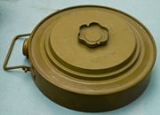
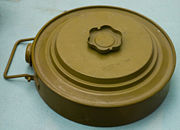
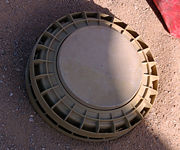

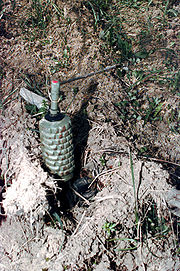
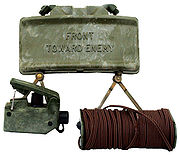
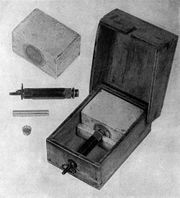


.jpg)

